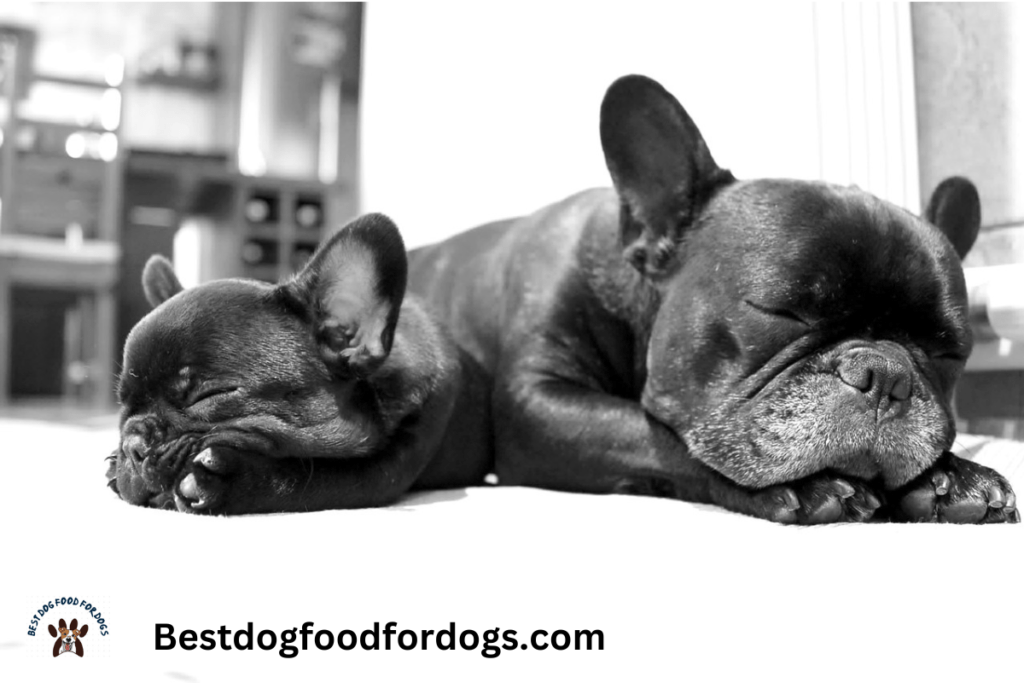Bringing home a litter of newborn French Bulldog puppies is an exciting—and demanding—responsibility. Their tiny bodies and developing immune systems require round-the-clock attention. From setting up the whelping box to ensuring proper nutrition for Frenchie puppies, every detail matters in supporting healthy growth. It’s also important to understand Frenchie breeding limits to protect the long-term well-being of both the dam and her future litters. This guide walks through every step, including early socialization, to help your puppies thrive in those critical early weeks.
Setting Up the Whelping Area
A safe, cozy whelping box is essential from birth through the first three weeks:
- Location: Quiet spot away from drafts and household traffic.
- Bedding: Use absorbent, washable pads topped with soft towels; change daily.
- Barriers: Low rails (“pig rails”) prevent puppies from getting trapped in corners.
- Cleanliness: Disinfect the box before arrival and maintain a strict cleaning routine to minimize infection risks.
As the puppies grow and begin transitioning out of the whelping area, knowing the right crate size for Frenchies becomes important for their comfort and safety. Position a low-wattage heat lamp or ceramic heater above one end so puppies can move to cooler areas if they overheat.
Feeding Schedule & Nutrition
Newborn puppies need to be fed every 2–4 hours:
- Natural Nursing: Encourage nursing from the dam; check that each puppy latches and swallows.
- Supplemental Formula: If the mother’s supply is low, offer a high-quality puppy milk replacer (no cow’s milk). Bottle-feed with a small-teat puppy bottle, keeping the head elevated slightly to mimic nursing.
- Introducing Solids: Around three weeks, begin mixing moistened puppy kibble or freeze-dried meat into formula; gradually increase solids while decreasing milk replacer.
Monitor weight daily—healthy puppies gain about 5–7% of their birth weight each day.

Maintaining Optimal Temperature
Puppies cannot regulate their body heat for the first two weeks:
- Week 1: Keep ambient temperature at 88–90°F (31–32°C).
- Week 2: Gradually reduce to 84–86°F (29–30°C).
- Week 3–4: Lower further to 80–82°F (27–28°C), then transition to normal room temperature by week five.
Use a digital thermometer in the box, and always provide cooler zones so puppies can self-regulate their comfort.
Stimulating Elimination
Newborns need help to urinate and defecate for the first three weeks:
- Frequency: After every feeding, gently massage the perineal area with a warm, damp cotton pad or soft cloth for 30–60 seconds.
- Cleanliness: Use a fresh pad each time; dispose of waste and sanitize your hands to prevent bacterial spread.
Once puppies consistently eliminate on their own (around week three), you can taper off stimulation.
Hygiene & Grooming Basics
Even with short coats, cleanliness is vital:
- Daily Checks: Wipe bellies and paws with a damp cloth to remove formula, feces, or urine.
- Bathing: Only if necessary—and always with a mild, puppy-safe shampoo—then dry immediately under a warm lamp.
- Bedding Care: Change and launder all bedding daily; disinfect the whelping box weekly.
Trim nails carefully once they’re long enough to scratch the dam or littermates, usually around two weeks old.
Caring for the Nursing Dam
A healthy mother is the cornerstone of puppy survival:
- Nutrition: Provide a high-calorie, balanced diet—up to 25–50% more calories than her normal intake—rich in protein and healthy fats.
- Hydration: Keep fresh water available at all times; consider mixing a canine-formulated electrolyte supplement.
- Rest & Comfort: Encourage quiet rest between nursing; monitor her incision if she had a C-section, and administer all prescribed pain relief and antibiotics.
Rotate a helper in shifts—newborn care is a 24-hour commitment, and the dam needs rest to produce quality milk.
Weaning onto Solid Food
Around four weeks, the transition to solid food begins:
- Gruel Introduction: Mix puppy kibble with warm water or formula to a porridge-like consistency.
- Supervised Meals: Place shallow dishes in the box; guide puppies to taste and lap food.
- Gradual Shift: Over two weeks, reduce liquid until they eat dry or slightly moistened puppy food.
By six to seven weeks, most Frenchie pups can fully digest solid kibble.
Early Socialization & Exercise
From three weeks onward, handle and interact gently to build confidence:
- Handling: Short, calm cuddles—touch paws, ears, and bellies to desensitize.
- Playtime: Supervised floor time outside the box on non-slippery surfaces encourages coordination.
- Environmental Exposure: Introduce soft sounds (voices, low-volume music) and different textures underfoot (carpet, rubber mats).
These early experiences shape puppy temperament and reduce anxiety in new surroundings.
Frequently Asked Questions (FAQs)
1. How often should I feed newborn French Bulldog puppies?
Newborn Frenchies require feeding every 2–4 hours around the clock for the first two weeks. Whether nursing from the dam or using a puppy milk replacer, small, frequent meals support their rapid growth and prevent dehydration.
2. What temperature should the whelping box be for French Bulldog pups?
Maintain 88–90°F (31–32°C) during week one, then gradually lower to 80–82°F (27–28°C) by week four. Always provide a cooler zone so puppies can move away from excessive heat.
3. When can I start weaning French Bulldog puppies onto solid food?
Begin introducing a gruel of moistened puppy kibble mixed with warm water or formula at three to four weeks old. By six to seven weeks, most Frenchie pups transition fully to solid puppy food.
4. How do I stimulate newborn French Bulldog puppies to eliminate?
After each feeding, gently massage the perineal area with a warm, damp cotton pad or soft cloth for 30–60 seconds. Continue twice daily until pups start eliminating independently around three weeks of age.
5. When should I begin socializing and handling French Bulldog puppies?
Start gentle handling and exposure to different textures and sounds at three weeks old. Short, calm cuddles and supervised play on varied surfaces build confidence and reduce future anxiety.

